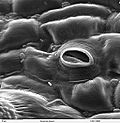Epidermis (botany)
Epidermis (botany) is the outermost layer of cells in plants, serving as a protective barrier between the plant and its environment. The epidermis plays a crucial role in minimizing water loss, regulating gas exchange, and protecting against pathogens and physical damage. It is a single layer of cells found in leaves, stems, roots, flowers, and fruits of plants.
Structure
The epidermal layer is composed of various cell types, including epidermal cells, guard cells, trichomes, and stomata. Epidermal cells are closely packed to form a continuous layer without intercellular spaces, which helps in preventing water loss. Guard cells are specialized epidermal cells that control the opening and closing of stomata, thereby regulating gas exchange and transpiration. Trichomes are hair-like structures that can help in reducing water loss and may also serve as a defense mechanism against herbivores. The stomata are small openings on the surface of leaves and stems that allow for gas exchange.
Function
The primary function of the epidermis is to protect the plant from environmental stresses such as drought, extreme temperatures, UV radiation, and pathogen invasion. It also plays a significant role in water conservation by reducing transpiration, thanks to its waxy coating known as the cuticle. The cuticle is a hydrophobic layer that covers the epidermis and is primarily composed of cutin and waxes. This layer is thicker in plants from arid environments, which helps in reducing water loss.
In addition to protection and water conservation, the epidermis is involved in the process of photosynthesis in some plants. Certain epidermal cells may contain chloroplasts, enabling them to contribute to the production of food for the plant. Furthermore, the regulation of gas exchange through the stomata is vital for photosynthesis and respiration.
Development
The development of the epidermis begins early in the plant's life cycle, with the differentiation of epidermal cells from the protoderm, a layer of meristematic cells. The pattern and distribution of epidermal cells, stomata, and trichomes are genetically controlled and can be influenced by environmental factors. Research into the molecular mechanisms governing epidermal development has revealed the involvement of several key genes and signaling pathways.
Evolutionary Significance
The evolution of the epidermis has been pivotal in enabling plants to colonize terrestrial environments. The development of a protective barrier against water loss, UV radiation, and pathogens was essential for the transition from aquatic to terrestrial life. The epidermis, with its various adaptations such as the cuticle, stomata, and trichomes, represents a significant evolutionary advancement in the plant kingdom.
See Also
Epidermis (botany)
Transform your life with W8MD's budget GLP-1 injections from $125.
W8MD offers a medical weight loss program to lose weight in Philadelphia. Our physician-supervised medical weight loss provides:
- Most insurances accepted or discounted self-pay rates. We will obtain insurance prior authorizations if needed.
- Generic GLP1 weight loss injections from $125 for the starting dose.
- Also offer prescription weight loss medications including Phentermine, Qsymia, Diethylpropion, Contrave etc.
NYC weight loss doctor appointments
Start your NYC weight loss journey today at our NYC medical weight loss and Philadelphia medical weight loss clinics.
- Call 718-946-5500 to lose weight in NYC or for medical weight loss in Philadelphia 215-676-2334.
- Tags:NYC medical weight loss, Philadelphia lose weight Zepbound NYC, Budget GLP1 weight loss injections, Wegovy Philadelphia, Wegovy NYC, Philadelphia medical weight loss, Brookly weight loss and Wegovy NYC
|
WikiMD's Wellness Encyclopedia |
| Let Food Be Thy Medicine Medicine Thy Food - Hippocrates |
Medical Disclaimer: WikiMD is not a substitute for professional medical advice. The information on WikiMD is provided as an information resource only, may be incorrect, outdated or misleading, and is not to be used or relied on for any diagnostic or treatment purposes. Please consult your health care provider before making any healthcare decisions or for guidance about a specific medical condition. WikiMD expressly disclaims responsibility, and shall have no liability, for any damages, loss, injury, or liability whatsoever suffered as a result of your reliance on the information contained in this site. By visiting this site you agree to the foregoing terms and conditions, which may from time to time be changed or supplemented by WikiMD. If you do not agree to the foregoing terms and conditions, you should not enter or use this site. See full disclaimer.
Credits:Most images are courtesy of Wikimedia commons, and templates, categories Wikipedia, licensed under CC BY SA or similar.
Contributors: Prab R. Tumpati, MD





